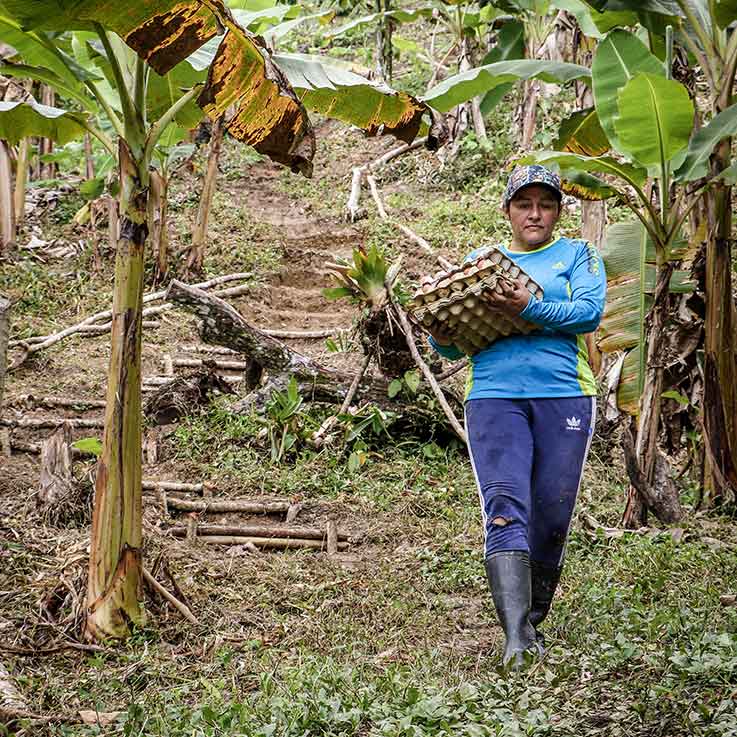
International Lessons on Building Resilient, Cross-Sector Partnerships
International Lessons on Building Resilient, Cross-Sector Partnerships
By focusing on three principles—shared goals, open acknowledgement of differing incentives, and the reduction of hierarchy and centralized strategy—organizations can build stronger partnerships, with an emphasis on action.
By Conor Seyle & Maureen Connolly Dec. 7, 2020
Emilse was first displaced from her home in Colombia when her father was killed in 1981. Her family resettled and farmed rice and sesame, but ongoing violence in the country forced them to move again in 2002. Lacking options to support her family’s livelihood, she joined tens of thousands of other displaced people in growing coca, a crop eventually processed into cocaine and sold to violent criminal groups.
Fourteen years later, in 2016, a deal between the Colombian government and the Revolutionary Armed Forces of Colombia (FARC) not only brought peace, but also opened the door to a new approach in dealing with the problem of illicit crops. The agreement called for a program that would provide incentives to farmers who volunteered to replace their illicit crops with legal ones.
It quickly became evident, however, that scaling the program quickly enough would require more than just government intervention. So the government turned to an emerging trend in international partnerships: civil society joining business to collaboratively solve social problems. In late 2019, it established a partnership between the PASO Colombia program (part of the US-based One Earth Future Foundation), the UN Multipartner Trust Fund for Sustaining Peace in Colombia, and local businesses. This partnership created a pipeline for economic support, agriculture extension training, and market development. And ultimately, it gave Emilse and others new opportunities to grow food crops that support both their families and peacebuilding in the region.
This illustrates one way government agencies and other organizations that work internationally are starting to change how they operate. When core institutions of the post-war world, such as the United Nations and the World Bank, came into being in the 1940s and 50s, an average of four international nongovernmental organizations (INGOs) formed for every formal, state-based international organization. The ratio has risen sharply in the late 20th and early 21st centuries. At the same time, governments and international governmental organizations have become increasingly aware of the complexity and interconnectedness of many international problems, and have realized that solving complex problems requires collaborative work from all sectors. This is especially true in the case of peacebuilding—arguably the ultimate complex problem. Organizations like the World Bank, the United Nations, and the US government have acknowledged that military force alone can never achieve peace; rather, peace requires multiple interventions that address different aspects of instability.
But of course, working across sectors is challenging. An assessment of civil coordination between NATO civilian and military organizations in Afghanistan, for example, bluntly concluded: “The importance of a comprehensive approach was recognized, but one did not materialize.” The US State Department’s “Stabilization Assistance Review” report identified consistent failures of coordination arising from issues with strategy and process, and assessments of UN work have argued that there are so many uncoordinated groups operating alongside each other that they should best be conceptualized as “organized anarchy.” These assessments have identified problems such as misaligned incentives; tensions that occur when people are trained to think in one way, then asked to incorporate other perspectives (such as a development worker asked to think about security dynamics); and resistance to hierarchy.
We need new processes to unlock the potential of multisector coordination. Over the past several years, our organizations, One Earth Future and Partnerships for Social Change, have been working with UN agencies and other groups to develop a model called Innovation in Partnerships. Used in the recent UN75 Global Governance Forum, it led to 20 new partnerships to support progress toward the UN’s 2030 Agenda for Sustainable Development. It identifies partners and engages them in dialogue that leads to commitments to action, and is based on three guiding principles: shared goals, open acknowledgement of differing incentives, and collective impact strategies that reduce or remove hierarchy and centralized strategy. In practice, organizations have to manage achieving all of these simultaneously while maintaining an emphasis on action to move the goals of the partnership forward. This can be a challenge when the demands of the different principles collide, but it’s nevertheless possible.
Principle One: Shared Goals
It’s important that partners have a shared understanding of the goal they are working toward. Complex systems by definition resist linear theories of change, so a collective response must agree on a strategic end goal, then monitor collective performance against it.
This is easy to say but difficult to do in practice. That’s because the organizations that participate affect how the group defines the goal, and the negotiation of the goal is itself a political action that can generate winners and losers. At the same time, understanding the intended goal can help identify who needs to participate. Our model thus starts with a convener or project leader who says, “This is the problem we want to address.” For example, a project may form around the need to combat tax evasion as a cause of inequality, as the Good Global Citizens project does. Stating the problem lays the foundation for identifying who is well-positioned to play a direct role in solving or addressing it. For example, participants in the tax evasion project include NGOs interested in transparency and accountability, big financial institutions like the International Monetary Funds, and international entities that work on financial flows like the United Nations Conference on Trade and Development. From there, the initial community can refine the goal to something discrete.
Principle Two: Open Acknowledgment of Differing Incentives
Partners often agree at the strategic level that they share the same ultimate goal but don’t adapt lower-level, internal decision-making processes (such as resource allocation or measurement) to meet that goal. A related, but often unstated issue in international contexts is the fact that state and INGO home offices impose different pressures on collaborators and incentivize them in different ways. Ignoring these differences—or worse, assuming they don’t exist—is a recipe for misalignment and often failure.
Partners should formally share their incentives and restrictions during project planning. Some could be reluctant for political or strategic reasons to release information showing that the project failed to meet its goals. Knowing that constraint upfront allows other partners to weigh their strategy against it, and help shape the partnership’s goals and information-sharing practices accordingly. Obviously, discussing these issues openly requires a high degree of trust between participants, so sometimes it’s most effective for the project lead to hold quiet, bilateral discussions with some participants to understand what they’re comfortable disclosing.
Principle Three: Models of Collective Organization That Reduce Hierarchy
One reason for the fragmentation and ineffectiveness of the 2001-2014 NATO partnership in Afghanistan was the US military’s push for a unified decision-making structure that European partners and civilian agencies resisted. This illustrates a challenge with approaches that try to develop a unified hierarchy: Relatively few partners are willing or able to surrender their autonomy. And so collaborative projects face a dilemma. Without some structure for developing collaborative approaches, there’s no real coordination, yet overly restrictive or hierarchical approaches reduce the willingness of other groups to participate.
An alternate approach, explored in previous SSIR articles on leadership and capacity building, is based on network administrative structures that maximize information-sharing and improve the ability of participating organizations to make the best decisions they can. Participating organizations are accountable to their own commitments through public awareness of those commitments, but there is no formal mechanism for forcing compliance. This can work well in small, limited partnerships, as well as more complex, cross-sector partnerships.
Partners should develop information-sharing mechanisms that inform each other’s decisions. They should share their independent plans and commitments, and collectively track and discuss activities. Some groups may update their progress and track what they have achieved via an online platform; others may simply hold regular meetings. Partnerships sometimes form working groups to address specific tasks or participate in global events to showcase progress and build momentum. Whatever paths partners take, it’s important to remember that maximizing each partner’s individual priorities as part of the collective whole encourages ongoing participation.
Implementation in Action
As we mentioned at the beginning, it’s important to balance the multiple, competing priorities that emerge from these principles with a bias toward action. Partners should work to resolve tensions between the different principles as they go, and—while maintaining an emphasis on network structures—ensure that there is some form of accountability tied to next steps.
The Partnership Dialogue for Connectivity—a project emerging from the recent UN75 Global Forum that we facilitated and that aims to improve the ability of people everywhere to access broadband connectivity—offers a good, step-by-step example of how to implement the process.
1. Identify a project lead and an initial project scope. The distributed nature of the network means the project lead has no formal authority and is therefore not the project manager. Instead, the project lead organizes the initial participants and the problem domain, then works iteratively to develop the final group of participants and problem scope.
In our discussions with UN entities as a part of the Global Forum, the International Telecommunication Union (ITU) expressed a desire to develop a partnership to improve digital connectivity. As a body of the UN focused on improving information and communications technologies, it made sense for ITU to act as the project lead for the Partnership Dialogue for Connectivity. It had the knowledge and connections to set the scope and identify who to include in the first round of outreach.
2. Identify and solicit participants. Next, the project lead reaches out to potential partners across a variety of sectors and holds a scoping meeting. During this first meeting, participants finalize their understanding of the basic problem the project will address and devise an agreement in principle about what the basic solution looks like. Because this approach can easily lead to the accidental exclusion of important voices, groups should carefully assess who’s missing from the room and take steps to fill any gaps.
With the Partnership Dialogue for Connectivity, the ITU reached out to a range of companies, civil society organizations, and governmental groups to gauge their interest and formulate the initial group. Partners included Facebook, the Global System for Mobile Communications Association, Microsoft, SpaceX, the UN Global Compact, UNICEF, European Middle East, and Africa Satellite Operators Association, Alphabet’s Loon, and the World Economic Forum. The group framed its problem statement in terms of how COVID-19 made digital connectivity a condition for participating in the global economy, and the need to reinforce the digital infrastructure to allow access to telework, e-commerce, remote learning, and telemedicine. This first meeting helped develop a shared, concrete goal and develop some initial discussions around differing incentives.
3. Suspend planning to allow for shifting participants. In addition to defining the problem, the first meeting helps clarify what kinds of capacities and skills the project needs to succeed and whether any organizations don’t want to participate in the ultimate project. An interim period between this and the second meeting allows the project lead to talk to participants bilaterally about their interest and who else needs to participate. It also gives the project leader an opportunity to discuss participants’ personal and institutional needs, separate from the strategic goals of the project, and to bring in new partners.
In the case of the Partnership Dialogue for Connectivity, nobody dropped out between the first and second meetings, and nobody needed to join—but partnerships shouldn’t necessarily expect that result. This stage is important to filling in gaps and ensuring that the right partners are engaged.
4. Hold a second meeting that culminates in a formal agreement. In this meeting, participants share their personal and institutional interests and limitations, and volunteer actions they can take. With better information about what others are doing to solve the problem, partners can make better decisions about how they can contribute.
With the Partnership Dialogue for Global Connectivity, participants committed jointly and collaboratively to work together and with other willing partners to improve digital connectivity on a global scale. They also agreed on next steps, such as developing a shared methodology to build infrastructure for digital connectivity. As things progress, partners will share information about planned activities, target areas, and priorities via a central platform, and then jointly determine a way forward based on overlapping interests and best practices.
5. Execute the plan. Once partners have created an agreement about what they will do, the project lead works with the participants to make sure the plans are detailed and include target areas, country representation, milestones, budgets, and desired outcomes.
The Partnership Dialogue for Global Connectivity undertook the first four steps of this process in the four months leading up to the UN75 Global Governance Forum. It’s now moving into a more active stage; participants are developing a work plan to promote connectivity in specific areas while sharing best practices and knowledge with other partners. As the partners execute these plans over the next three years, the ITU will measure the overall impact of their work on connectivity, including progress against the Sustainable Development Goals.
6. Accelerate, broaden, and scale. Some partnerships are sufficient to achieve the shared goal from the beginning, but as partnerships go on, groups often realize they need new partners or have opportunities to accomplish more than they set out to do. As a project matures, partners will also identify new ways to work. While this stage still lies ahead for the Partnership Dialogue for Global Connectivity, the group will likely bring in new, in-country partners and INGOs to expand connectivity.
While the challenges the Colombian government faced in transitioning farmers away from coca production are very different from the post-COVID, digital connectivity challenges the United Nations is facing, both problems have lacked any single-sector solution and have needed groups to work together in a cohesive fashion. Thanks to the partnership between the Colombian government, civil society groups, and local businesses, Emilse is now one of more than 1,500 women and 400 men growing legal crops as part of a new and growing local economy. And while the digital connectivity partnership that emerged from the Global Forum is just beginning its implementation phase, it’s on track to expand connectivity to 10 regions, providing new physical and administrative infrastructure to improve access to online communications. Both partnerships have been guided by principles that most other international partnerships are missing or that commonly break down over time. By working through shared goals, differing incentives, and issues related to hierarchy, international partnerships tackling complex problems have the potential to move beyond agreements that sound good in principle to coordinated, effective, real-world action.










